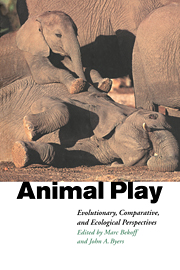Book contents
- Frontmatter
- Contents
- List of contributors
- Introduction
- 1 The evolutionary origins of play revisited: lessons from turtles
- 2 Play in common ravens (Corvus corax)
- 3 Object play by adult animals
- 4 Kangaroos at play: play behaviour in the Macropodoidea
- 5 Intentional communication and social play: how and why animals negotiate and agree to play
- 6 Structure-function interface in the analysis of play fighting
- 7 Sparring as play in young pronghorn males
- 8 Squirrel monkey play fighting: making the case for a cognitive training function for play
- 9 Self assessment in juvenile play
- 10 Biological effects of locomotor play: getting into shape, or something more specific?
- 11 Neurobiological sustrates of play behavior: glimpses into the structure and function of mammalian playfulness
- 12 Play as an organizing principle: clinical evidence and personal observations
- Index
11 - Neurobiological sustrates of play behavior: glimpses into the structure and function of mammalian playfulness
Published online by Cambridge University Press: 20 November 2009
- Frontmatter
- Contents
- List of contributors
- Introduction
- 1 The evolutionary origins of play revisited: lessons from turtles
- 2 Play in common ravens (Corvus corax)
- 3 Object play by adult animals
- 4 Kangaroos at play: play behaviour in the Macropodoidea
- 5 Intentional communication and social play: how and why animals negotiate and agree to play
- 6 Structure-function interface in the analysis of play fighting
- 7 Sparring as play in young pronghorn males
- 8 Squirrel monkey play fighting: making the case for a cognitive training function for play
- 9 Self assessment in juvenile play
- 10 Biological effects of locomotor play: getting into shape, or something more specific?
- 11 Neurobiological sustrates of play behavior: glimpses into the structure and function of mammalian playfulness
- 12 Play as an organizing principle: clinical evidence and personal observations
- Index
Summary
Introduction
There is no shortage of descriptive literature on play behavior, nor is there a lack of theories as to the putative functions and evolutionary origins of play. But despite this wealth of information and speculation, very little is known about how the brain is involved in playfulness. We can presume that those animals which play do so because their brains evolved in a way that favored the presence of certain types of neural circuitry, the activation of which results in behaviors that we can readily identify as being playful. Since it is now fairly well established that play is a distinct behavioral entity and not simply the juvenile form of more adult-typical behaviors (e.g., Fagen 1981), it can also be assumed that play would be represented by a distinct neural topography. This is not to say that overlap doesn't exist between brain areas involved in play and brain areas involved in other behaviors. For example, it would be expected that the pleasure derived from engaging in playful interactions taps into neural systems which code pleasure derived from other behaviors. Similarly, those systems which are involved in the actual patterning of movements exhibited during play would not be expected to differ greatly from those involved in motor patterning of other behaviors. The neural uniqueness of play may be in how these individual neural units are combined, and which types of stimuli initiate them.
Play has often been thought of as a distinctly mammalian behavior pattern (e.g., MacLean 1990). Such an assumption would make the search for neural systems involved in play relatively straightforward in that the search could be limited to parts of the brain unique to mammals.
- Type
- Chapter
- Information
- Animal PlayEvolutionary, Comparative and Ecological Perspectives, pp. 221 - 242Publisher: Cambridge University PressPrint publication year: 1998
- 32
- Cited by

